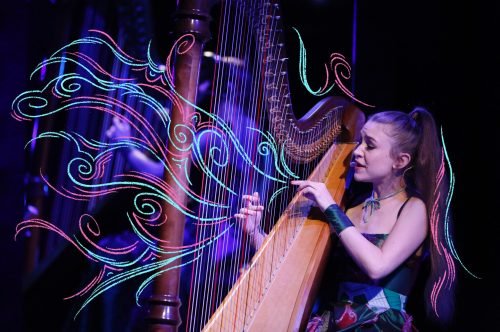In the quiet of her Northern California home, a young Joanna Newsom would often be found sitting at her harp, fingers dancing across the strings, weaving melodies that seemed to resonate with the very soul of the instrument. This deep connection with her harp has remained a defining element of Newsom’s music, captivating audiences worldwide.
Delve into Joanna Newsom’s technical mastery of the harp and explores how she harnesses its capabilities to evoke a wide range of moods and emotions. By analyzing her use of specific harp techniques and her innovative approach to creating unique soundscapes, we aim to shed light on how Newsom’s harp playing contributes to her distinctive musical style and the emotional depth of her work.
The Harp: An Overview
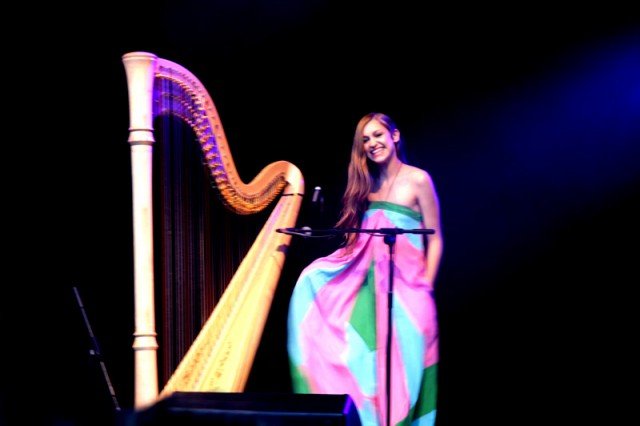
Instrumental Complexity
The harp, an instrument of ancient origins, is renowned for its ethereal sound and intricate structure. Typically, a concert harp stands about six feet tall and boasts a triangular frame with 47 strings and seven pedals. The strings are made from gut, nylon, or metal, and are stretched across a wooden soundboard. The pedals, located at the base, allow the harpist to change the pitch of the strings, enabling the production of sharps, naturals, and flats.
Playing the harp requires exceptional dexterity and coordination. Harpists use both hands, with the right hand typically playing higher notes and the left hand handling the lower register. Each finger, except for the pinky, is used to pluck the strings. The complexity arises not only from the need to read and play multiple lines of music simultaneously but also from the constant adjustment of the pedals to accommodate key changes. This dual task of finger movement and pedal coordination makes the harp one of the most challenging instruments to master.
Historical Context
The harp is one of the oldest musical instruments, with depictions found in ancient Egyptian tombs dating back to 2500 BCE. These early harps were simple bow-shaped instruments without pedals. As the centuries passed, the harp evolved in complexity and design, spreading across various cultures and regions.
In medieval Europe, the harp became a prominent instrument in both courtly and folk music. The Celtic harp, or cláirseach, was particularly significant in Ireland and Scotland, where it became a symbol of cultural identity. By the Renaissance, the harp had developed into a larger and more sophisticated instrument, featuring gut strings and increased string tension, which allowed for greater musical expression.
The introduction of the double-action pedal harp in the early 19th century by Sébastien Érard marked a significant milestone in the instrument’s evolution. This innovation enabled harpists to play in any key by allowing each string to be shortened by a semitone or a whole tone via the pedals. This development transformed the harp into a versatile and dynamic instrument, suitable for both orchestral and solo performances.
Throughout the 20th and 21st centuries, the harp continued to find its place in various musical genres, from classical and jazz to contemporary and experimental music. Pioneering harpists like Marcel Grandjany, Carlos Salzedo, and Alice Coltrane expanded the instrument’s repertoire and playing techniques, pushing the boundaries of what the harp could achieve.
Joanna Newsom, with her innovative approach and deep understanding of the harp’s capabilities, stands as a modern-day torchbearer of this rich tradition. By blending classical techniques with folk sensibilities and avant-garde experimentation, she has carved out a unique space for the harp in contemporary music, demonstrating its timeless appeal and boundless potential.
Technical Mastery
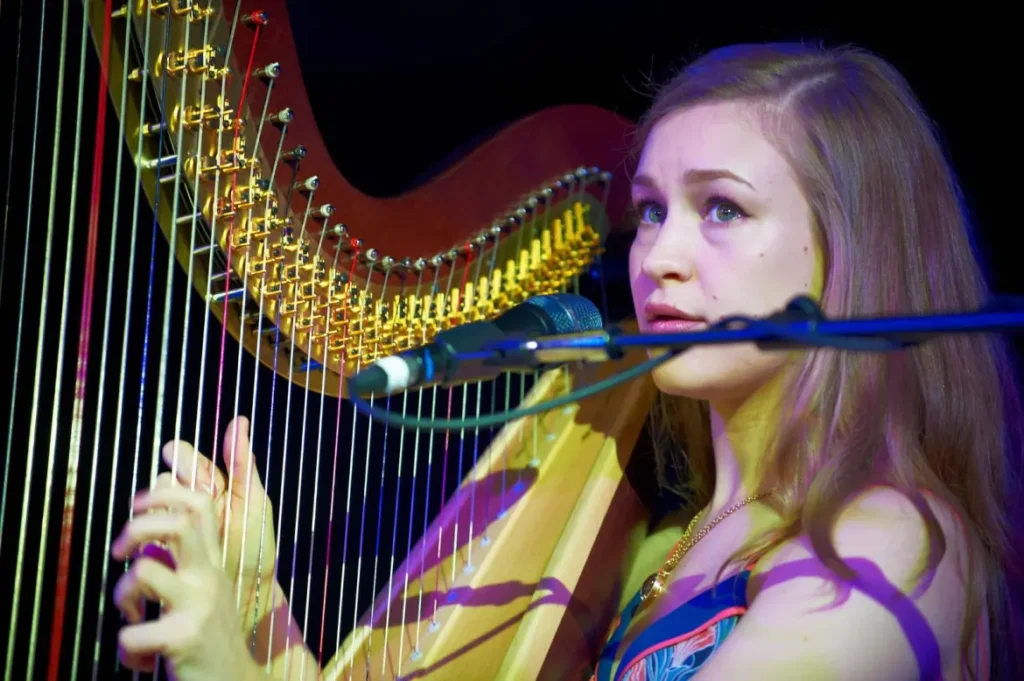
Harp Techniques
Joanna Newsom’s mastery of the harp is evident in her intricate and emotive playing, which incorporates a variety of advanced techniques. Here are some of the key techniques she employs:
Fingerpicking: Newsom’s fingerpicking style is characterized by its precision and complexity. She uses her fingers to pluck individual strings, creating intricate melodic lines and harmonies. Her ability to weave multiple voices simultaneously is a testament to her technical prowess and deep understanding of the instrument.
Glissandos: This technique involves rapidly sliding the fingers across the strings, producing a sweeping, cascading sound. Newsom uses glissandos to add dramatic flourishes to her music, creating moments of grandeur and emotional intensity.
Harmonics: By lightly touching the strings at specific points, Newsom can produce bell-like harmonic tones. These ethereal sounds add a layer of shimmering texture to her compositions, enhancing the dreamlike quality of her music.
Pres de la Table: Playing close to the soundboard, or “pres de la table,” Newsom achieves a more percussive and muted sound. This technique is particularly effective in creating rhythmic complexity and dynamic contrast within her pieces.
Arpeggios: Newsom frequently uses arpeggios—playing the notes of a chord in rapid succession rather than simultaneously. This technique allows her to build rich, flowing harmonic progressions that underpin her melodies with lush, supportive textures.
Innovative Approaches
What sets Joanna Newsom apart from traditional harpists is not just her command of these techniques but her innovative approach to using the harp in a contemporary musical context. Here are some of the unique methods and styles she employs:
Fusion of Genres:
Newsom blends elements of folk, classical, and indie music, creating a genre-defying sound. Her compositions often feature unconventional song structures and eclectic influences, ranging from medieval ballads to avant-garde experimentation. This fusion of styles showcases the harp’s versatility and challenges traditional notions of its role in music.
Narrative Lyricism:
Newsom’s lyrics are renowned for their poetic and narrative quality. She often weaves intricate stories and vivid imagery into her songs, using the harp to enhance the storytelling. The interplay between her voice and the harp creates a dialogue that brings her narratives to life, making each performance a deeply immersive experience.
Extended Techniques:
Beyond traditional playing methods, Newsom experiments with extended techniques to expand the sonic palette of the harp. This includes using unconventional plucking patterns, incorporating percussive elements, and exploring the full range of dynamics and timbres the instrument can produce. These explorations add a distinctive edge to her music, setting her apart from more conventional harpists.
Integration with Vocals:
One of Newsom’s most striking innovations is her seamless integration of harp and vocals. Unlike many harpists who separate instrumental sections from vocal parts, Newsom often plays complex harp arrangements while singing. This dual performance requires immense skill and coordination, allowing her to create densely layered and harmonically rich pieces that feel both intimate and expansive.
Personalized Tuning Systems:
To achieve specific sonic effects and accommodate her unique compositional style, Newsom sometimes employs personalized tuning systems. These custom tunings allow her to explore unconventional harmonic relationships and create distinctive tonal landscapes that are uniquely her own.
Joanna Newsom’s technical mastery and innovative approaches have not only redefined the possibilities of the harp but have also opened new avenues for its use in contemporary music. Her ability to blend technical proficiency with creative experimentation makes her a trailblazer in the modern musical landscape, continually pushing the boundaries of what the harp can achieve.
Creating Unique Soundscapes
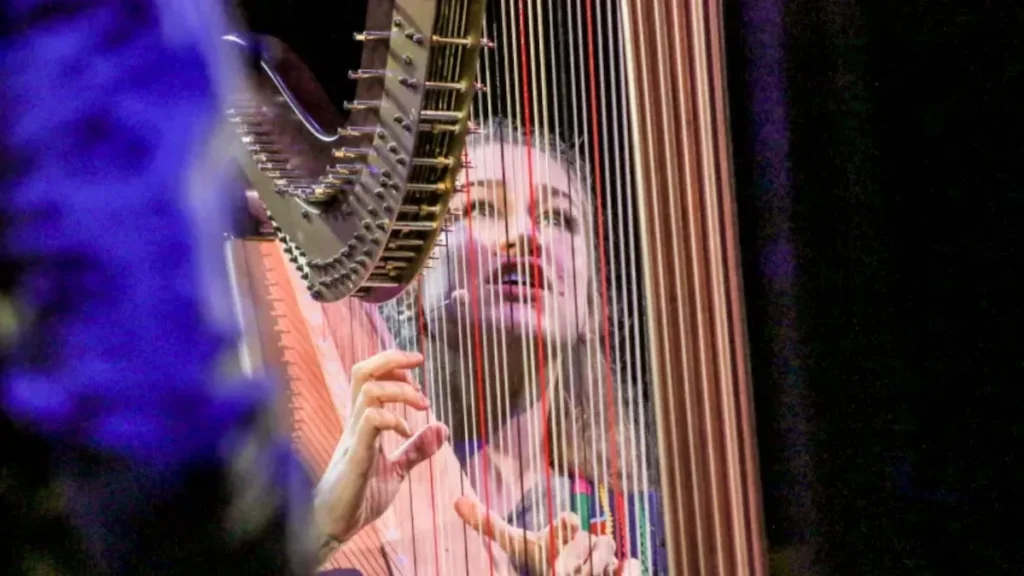
Layering and Texture
Joanna Newsom’s ability to create rich, textured soundscapes is a hallmark of her music. Her approach to layering harp sounds is both sophisticated and evocative, crafting auditory landscapes that draw listeners into her world.
Polyphonic Arrangements: Newsom often employs polyphony, playing multiple independent melodies simultaneously. This technique allows her to build intricate musical tapestries where each layer contributes to the overall texture. By interweaving these melodic lines, she creates a sense of depth and complexity that enhances the listening experience.
Dynamic Contrasts: Another key element in Newsom’s soundscapes is her use of dynamic contrasts. She skillfully transitions between soft, delicate passages and powerful, resonant climaxes. These dynamic shifts create a sense of movement and emotional ebb and flow, drawing listeners deeper into the narrative of each piece.
Repetitive Patterns and Ostinatos: Newsom often uses repetitive patterns and ostinatos to establish a rhythmic foundation. These recurring motifs provide a sense of continuity and cohesion, while subtle variations in these patterns add interest and keep the listener engaged. The hypnotic quality of these repetitions enhances the immersive nature of her music.
Harmonic Richness: Through her expert use of harmonics and extended chords, Newsom enriches her compositions with a wide palette of tonal colors. The interplay of harmonics, achieved by lightly touching the strings at precise points, adds a shimmering layer to her soundscapes. This harmonic richness is a key feature of her music, lending it an otherworldly quality.
Spatial Awareness: Newsom’s recordings often exhibit a keen awareness of spatial dynamics. She uses the natural resonance of the harp and careful microphone placement to create a sense of space and dimension. This spatial awareness allows her music to breathe and gives the listener the impression of being enveloped in sound.
Integration with Vocals and Other Instruments
Joanna Newsom’s seamless integration of the harp with her vocals and other instruments is another defining aspect of her sound. Her arrangements are carefully crafted to balance these elements, creating a cohesive and harmonious whole.
Interplay Between Harp and Voice:
Newsom’s vocal lines are often as intricate as her harp parts, with the two elements weaving in and out of each other. She uses her voice as another instrument, matching its phrasing and dynamics to those of the harp. This interplay creates a dialogue between the harp and vocals, enhancing the emotional impact of her songs.
Harmonizing with Voice:
In many of her songs, Newsom harmonizes her voice with the harp, creating lush, layered vocals that blend seamlessly with the instrumental backdrop. This technique adds a choral quality to her music, enriching the overall texture and providing additional layers of meaning and emotion.
Collaborations and Arrangements:
While the harp is central to Newsom’s music, she frequently collaborates with other musicians and incorporates a variety of instruments into her arrangements. Strings, woodwinds, and percussion are commonly featured, each adding their unique timbre to the mix. Newsom’s arrangements are meticulously constructed to ensure that each instrument complements the harp rather than competing with it.
Orchestral Influences:
Newsom’s music often reflects an orchestral sensibility, with arrangements that feel symphonic in scope. She uses the harp as a foundation upon which other instruments build, creating a rich and layered sound that is reminiscent of a chamber orchestra. This orchestral approach allows her to explore a wide range of sonic possibilities, from intimate solo passages to grand, sweeping crescendos.
Innovative Use of Sound:
Beyond traditional instrumentation, Newsom sometimes incorporates unconventional sounds and production techniques to enhance her music. This can include field recordings, electronic effects, and experimental sound manipulation. These elements add a unique and modern twist to her otherwise organic soundscapes, pushing the boundaries of genre and expectation.
Through her meticulous layering of harp sounds and innovative integration with vocals and other instruments, Joanna Newsom creates soundscapes that are both richly textured and deeply emotive. Her music invites listeners into a world where every note, every harmony, and every nuance contributes to a profoundly immersive experience.
Emotional and Mood Evocation
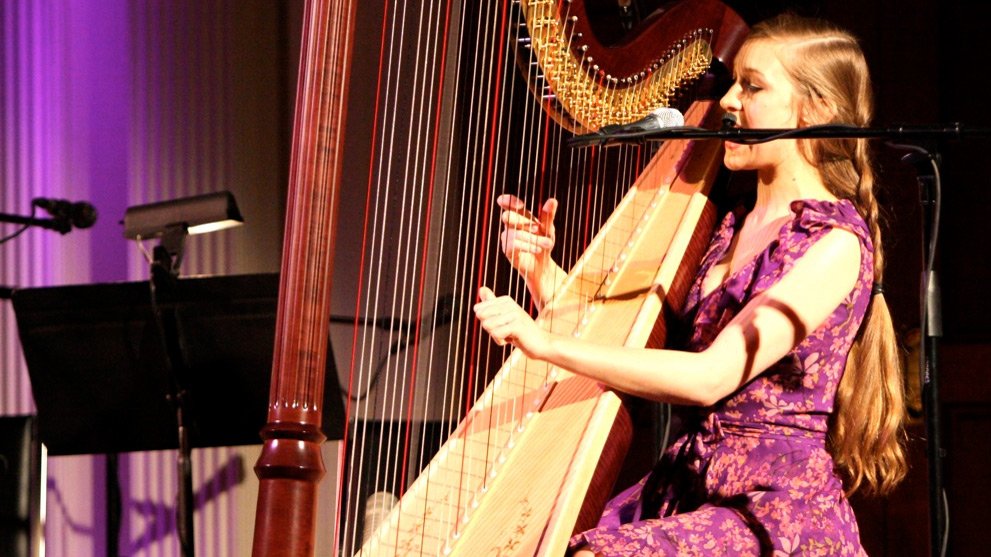
Melancholy and Serenity
Joanna Newsom’s harp playing is particularly adept at evoking feelings of melancholy and serenity, creating a deeply introspective atmosphere in her music. Her use of minor keys, slow tempos, and delicate, intricate fingerpicking can transport listeners to a place of quiet reflection.
For instance, in songs like “Clam, Crab, Cockle, Cowrie” from her album “The Milk-Eyed Mender,” Newsom’s gentle plucking and soft, melancholic vocals weave together to create a sense of wistful longing. The subtle use of harmonics and the careful spacing of notes allow the harp to breathe, fostering a serene and meditative soundscape. In “Sadie,” also from “The Milk-Eyed Mender,” the repetitive, soothing arpeggios and Newsom’s tender voice combine to evoke a deep sense of peace and introspection, capturing the essence of tranquility and sorrow intertwined.
Dramatic and Playful Tones
On the other end of the emotional spectrum, Newsom’s harp playing can be both dramatic and playful, adding dynamic contrast and vibrancy to her music. In the epic “Emily” from her album “Ys,” her harp serves as a foundation for the song’s dramatic narrative arc. The use of rapid glissandos and forceful plucking creates a sense of urgency and intensity, mirroring the song’s lyrical themes of celestial exploration and existential wonder. The interplay between the harp and orchestral arrangements heightens the drama, making the listener feel as if they are part of an unfolding story.
Newsom’s playful side is showcased in tracks like “Good Intentions Paving Company” from “Have One on Me.” Here, her lively harp playing is complemented by a jaunty piano and upbeat tempo, creating a whimsical and buoyant atmosphere. The playful interaction between the instruments, along with her dynamic vocal delivery, injects a sense of fun and spontaneity into the music. Similarly, “Cosmia,” from “Ys,” features complex, darting harp lines that dance around her vocals, adding a mischievous and lighthearted quality to the song. These examples highlight Newsom’s ability to use the harp not just as an instrument for creating serene and melancholic soundscapes but also as a tool for conveying drama and whimsy, demonstrating her versatile emotional range as a musician.
Case Studies: Key Songs and Albums
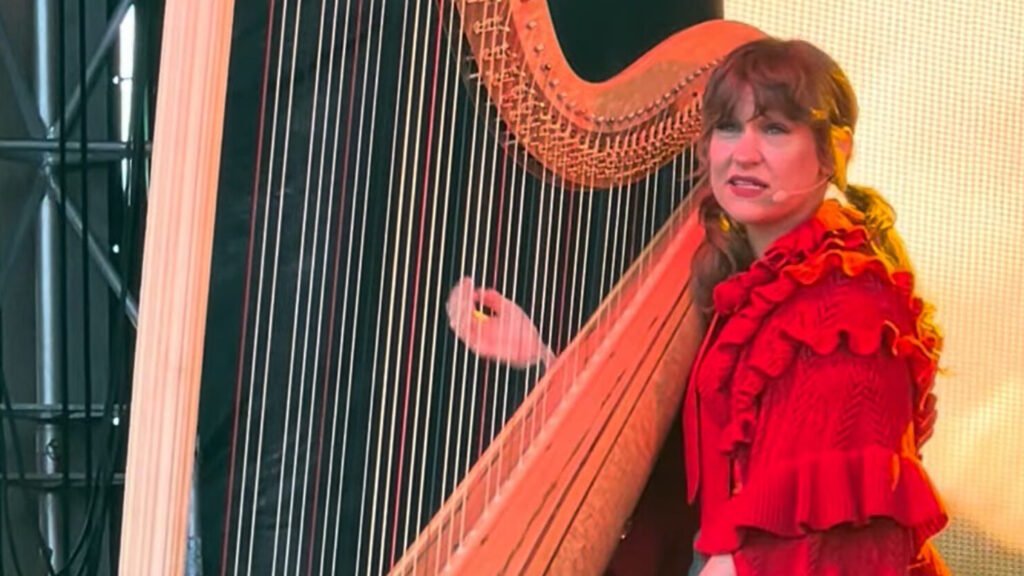
In-Depth Song Analysis
- “Emily” (from Ys)
“Emily” is a masterclass in Joanna Newsom’s use of the harp to create a complex emotional landscape. The song opens with delicate fingerpicking, establishing a gentle, contemplative mood. As the song progresses, Newsom employs a range of techniques, including arpeggios and glissandos, to build intensity and drama. The interplay between her harp and Van Dyke Parks’ orchestral arrangements creates a rich, layered texture. Newsom’s voice, floating above the intricate harp lines, adds to the song’s ethereal quality. The emotional impact of “Emily” is profound, capturing a sense of longing and wonder that resonates deeply with listeners.
- “Have One on Me” (from Have One on Me)
The title track of Newsom’s ambitious triple album showcases her ability to blend traditional harp techniques with modern songwriting. “Have One on Me” features a series of arpeggiated chords that create a rolling, almost hypnotic rhythm. Newsom’s use of dynamics, with subtle crescendos and decrescendos, adds depth and dimension to the piece. The song’s narrative structure, combined with the harp’s lyrical qualities, evokes a range of emotions, from melancholy to defiance. This track exemplifies Newsom’s skill in using the harp to support and enhance her storytelling.
- “Sapokanikan” (from Divers)
“Sapokanikan” is a prime example of Newsom’s innovative approach to the harp. The song opens with a lively, syncopated rhythm, with Newsom’s fingers dancing across the strings. Her use of repetitive motifs and intricate fingerpicking creates a playful, yet slightly unsettling atmosphere. As the song unfolds, the harp provides a steady undercurrent that supports the complex lyrical narrative. The emotional impact of “Sapokanikan” lies in its ability to convey a sense of historical depth and poignancy, with the harp playing a crucial role in the song’s overall effect.
Album Highlights
“The Milk-Eyed Mender” (2004)
Newsom’s debut album introduced her as a unique voice in contemporary music, with the harp front and center. The simplicity and clarity of her harp playing on tracks like “Sprout and the Bean” and “Peach, Plum, Pear” highlight her ability to create intricate, yet accessible melodies. The album’s folk-inspired sound and intimate production showcase her early mastery of the instrument and her distinctive lyrical style.
“Ys” (2006)
With Ys, Newsom expanded her musical horizons, incorporating lush orchestral arrangements and longer, more complex compositions. The harp is still central, but its role is more integrated with other instruments. Tracks like “Only Skin” and “Monkey & Bear” demonstrate her evolving technique and increased confidence in using the harp to convey complex emotions and narratives. The album’s ambitious scope and richly textured soundscapes mark a significant step forward in her artistic development.
“Have One on Me” (2010)
This triple album represents a culmination of Newsom’s exploration of the harp’s possibilities. With 18 tracks spanning over two hours, Have One on Me showcases her versatility and creativity. Songs like “In California” and “Go Long” highlight her ability to blend the harp with other instruments, creating intricate, multi-layered arrangements. The album’s diverse range of styles and moods reflects Newsom’s deepening relationship with the harp and her continued growth as a musician and songwriter.
“Divers” (2015)
Divers sees Newsom refining her approach, with tighter, more focused compositions. The harp remains a central element, but its use is more varied and nuanced. Tracks like “Leaving the City” and “Anecdotes” feature complex, syncopated rhythms and innovative harmonies, showcasing her technical prowess. The album’s thematic cohesion and emotional depth highlight Newsom’s maturity as an artist, with the harp serving as both a melodic and narrative anchor.
Through these key songs and albums, Joanna Newsom’s evolving relationship with the harp is evident. Her innovative techniques and emotional depth continue to push the boundaries of contemporary music, solidifying her place as a masterful harpist and visionary artist.
Final Thoughts
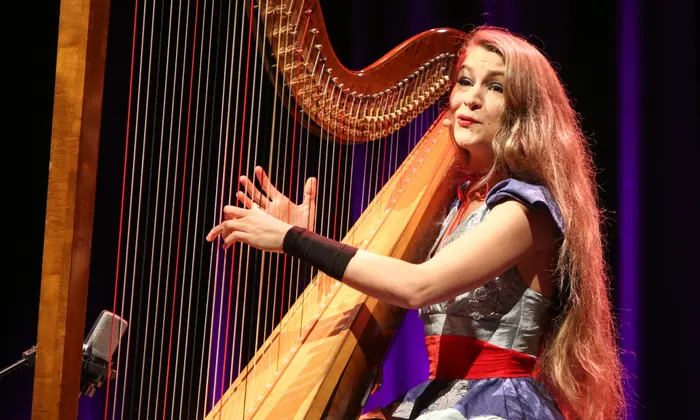
Joanna Newsom’s contribution to music is profound and multifaceted. Her ability to transform the harp from a classical and folk instrument into a central element of modern indie and experimental music is a testament to her creativity and technical skill. Newsom’s music is a captivating blend of intricate compositions, poetic lyricism, and emotional depth, all anchored by her extraordinary harp playing. Her work challenges conventional boundaries and invites listeners into a world where the harp’s delicate strings tell powerful stories and evoke a spectrum of emotions.
Call to Action
For those who have yet to fully appreciate the magic of Joanna Newsom’s harp playing, now is the perfect time to dive into her discography. Listen closely to the intricate melodies and harmonies she creates, and let the harp’s unique voice transport you to the enchanting soundscapes she meticulously crafts. Whether you are a long-time fan or new to her music, there is always something new to discover in the delicate and powerful interplay of her harp and voice. Embrace the allure of the harp through Joanna Newsom’s masterful artistry and experience the profound impact it brings to her exceptional body of work.
